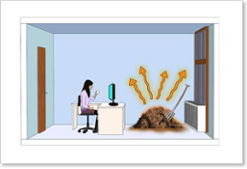
How to Improve Indoor Air Quality (IAQ)
3/27/2015
It is estimated that people spend about 90 percent of their time indoors. When all of this time is spent in a building with poor air quality, it can begin to have a detrimental effect on the overall comfort and health of its occupants. Unfortunately, most people do not know that issues with the home structure, as well as regular household products and habits can be the cause of indoor air quality issues. Whether you have lived in your home for a while or have a new one being built, there are steps that you can take to improve the indoor air quality before it has an impact on you or your family’s comfort and well-being.
For an existing home, it’s very important to first identify what could be causing IAQ issues and eliminate the problem at the source. Source control is often the most effective way to improve IAQ. Once pollutants are eliminated at the source, the next best option is diluting contaminants. It’s almost impossible to have no pollutants or contaminants in a building, so an HRV or ERV with the constant fresh-filtered air helps dilute the concentration to a comfortable level. The constant flow of fresh, filtered and pre-conditioned air will help maintain high indoor air quality and a comfortable indoor environment.
Signs That There May Be IAQ Issues
When there are indoor air quality issues, the problem will sometimes cause health symptoms in residents. These health symptoms may be subtle, so it is important to pay attention to when health problems begin to rule out other causes. If homeowners suspect that air quality may be at the root of health issues, a professional inspector can determine whether there are high levels of mold or other toxic substances present in the indoor air.
Health symptoms that may indicate problems with indoor air quality may include:
• Itchy eyes
• Skin irritation
• Stuffiness
• A persistent cough
• Prolonged illness
Improving Air Quality in New Homes
Home construction has come a long way in recent years, with many constructions companies and contractors focus more on using green building practices, greater air sealing and more insulation to build better homes. When building a home, one of the most important considerations is the building envelope. A tight building envelope needs a mechanical ventilation strategy. Installing a high-performance ventilation system, such as an HRV or ERV, can help owners of new homes to attain better comfort and air quality right from the start. Many builders are using this method to ensure more comfortable, healthy and energy-efficient homes.
Improving Air Quality in Older Homes
Installing an HRV or ERV in older homes can help to improve the air quality. However, it is important that homeowners also address other issues that may be impacting air quality. Materials that were commonly used in home and furniture construction in past years may emit harmful substances such as radon gas, so homeowners should pinpoint these problematic materials and take steps to remove and replace the materials. Homeowners should also meet with experts to determine the security of the building envelope.
Changes in Daily Habits for Better IAQ
Besides making changes to the building and ventilation system, home residents can also help to improve air quality by making certain changes to daily habits. Opting for more natural products, clothing, furniture, cleansers, and fragrances can help to reduce the number of volatile organic compounds that are introduced into the home environment daily. Keeping the home clean and free from dust can keep the air fresher and cleaner. Refraining from burning items such as cigarettes, candles, and kerosene lamps can help to reduce toxic emissions in the home.
